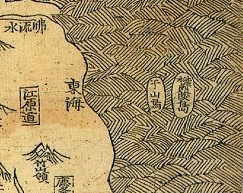Dokdo Museum
| Dokdo Museum | |
| Hangul | 독도박물관 |
|---|---|
| Hanja | |
| Revised Romanization | Dokdobangmulgwan |
| McCune–Reischauer | Toktopangmulkwan |
Dokdo Museum is the name used for two museums in Korea that relate to the Liancourt Rocks, known as Dokdo in Korean. One of the museums is located in Ulleungdo and the other, which opened later, is in Seoul.[1]
Ulleung-gun
[edit]
The Dokdo Museum in Ulleung is government run. It is underwritten by Samsung.[2][1] The museum was built in the shape of Sambongdo (三峰島, literally "Three Peaks Island," Liancourt Rocks' name in the Joseon Dynasty). The first curator, Lee Jong-Hak, collected many materials from all over the world. Dokdo Museum was also founded with help from Hong Sun-Chil, who was the leader of the Volunteer Guard of Dokdo. It is the only museum about territory in Korea.
The museum at Ulleungdo opened in 1995 or 1997[3][4] with a mission of collecting and researching the Rocks and the Sea of Japan. Korea aims to use this exhibit as a means of strengthening its claim over the rocks.[5]
Seoul
[edit]The Seoul Museum, operated by the Northeast Asian History Foundation opened in 2012.[1][6] The museum, which has a collection of maps and other documents,[7] focuses on education and virtual experiences and [8] forms part of what has come to be called Dokdo-ganda, propaganda as to the ownership of these islands.[9]
See also
[edit]References
[edit]- ^ a b c Wiegand, Krista E.; Choi, Ajin (1 January 2017). "Nationalism, public opinion, and dispute resolution: The Dokdo/Takeshima dispute". Journal of Asian Pacific Communication. 27 (2): 232–245. doi:10.1075/japc.27.2.05wie. Retrieved 14 March 2021.
- ^ Dudden, Alexis (4 March 2014). Troubled Apologies Among Japan, Korea, and the United States. Columbia University Press. p. 29. ISBN 978-0-231-14177-2. Retrieved 14 March 2021.
- ^ "Dokdo Museum". www.dokdomuseum.go.kr. Retrieved 14 March 2021.
- ^ "[Reportage] Additional construction in Ulleungdo to bolster South Korea's territorial control over Dokdo". The Hankyoreh. 27 October 2019. Retrieved 14 March 2021.
- ^ Card, James (4 January 2006). "A Chronicle of Korea-Japan 'Friendship'" (PDF). The Asia-Pacific Journal. 4 (1). Retrieved 14 March 2021.
- ^ Sachdeva, Sam (12 October 2018). "Korea peace talks expose some fault lines". Newsroom. Retrieved 14 March 2021.
- ^ Sang-Hun, Choe (5 October 2012). "Fight Over Rocky Islets Opens Old Wounds Between South Korea and Japan (Published 2012)". The New York Times. Retrieved 14 March 2021.
- ^ Park, SeongHui; Kim, KyoungHee (1 October 2017). "Analysis of the Dokdo Museum Seoul as a Virtual Experience Place". Advanced Science Letters. 23 (10): 9891–9894. doi:10.1166/asl.2017.9819. Retrieved 14 March 2021.
- ^ "South Korea craves foreign approval of its claim to two tiny rocks". The Economist. 27 September 2018. Retrieved 14 March 2021.
